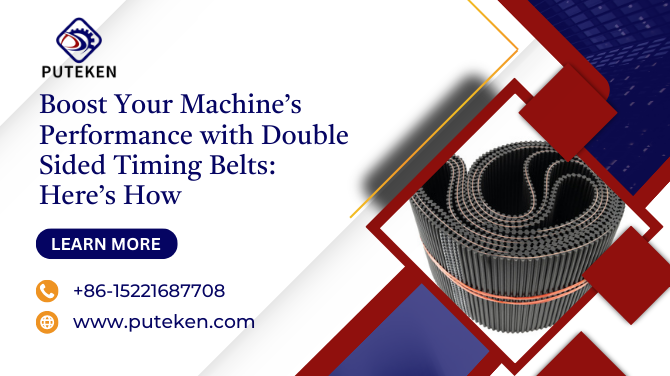
In the fast-paced industrial environment of today, accuracy and productivity are critical. Machines need to work seamlessly, without glitches, to keep production lines humming. If you’re looking to boost your machine’s performance, Double Sided Timing Belts could be the game-changer you’ve been searching for. These innovative belts offer bi-directional power transmission, making them ideal for complex machinery that requires synchronization on both sides of the belt.
What Are Double Sided Timing Belts?
On both sides of the belt, dual-sided timing belts are intended to provide power transmission. Unlike standard timing belts that transmit power on just one side, these belts have teeth on both surfaces, allowing them to drive pulleys in opposite directions simultaneously. This unique feature makes them perfect for machinery where space is limited, and synchronized motion is essential.
How Do Double Sided Timing Belts Work?
These belts operate by meshing the teeth with grooves on the pulleys, ensuring precise and slip-free power transmission. The teeth on both sides allow for dual-directional motion, which can simplify complex mechanical designs.
Think of it as a conveyor belt that can push and pull at the same time—efficient, right?
Types of Double Sided Timing Belts
There are different types of double sided timing belts designed for various applications. Let’s break down the most common types:
1. Dual-Sided Neoprene Timing Belts
Made from neoprene rubber, these belts offer excellent durability and resistance to wear and chemicals. They’re commonly used in general industrial applications.
2. Dual-Sided Polyurethane Timing Belts
These belts are well known for being incredibly robust and flexible. They are resistant to oil and abrasion, making them ideal for precision applications.
3. High-Torque Double Sided Timing Belts
Designed for heavy-duty machinery, these belts can handle higher torque loads without stretching or slipping.
Each type of belt has specific strengths, so choosing the right one depends on your machine’s requirements.
Benefits of Using Double Sided Timing Belts
Why should you invest in double sided timing belts for your machinery? Here are some compelling benefits:
1. Bi-Directional Power Transmission
The most obvious advantage is their ability to transmit power on both sides. This allows for complex designs where pulleys need to rotate in opposite directions without needing additional belts.
2. Space Efficiency
Double sided timing belts save valuable space in compact machines by eliminating the need for multiple belts. This streamlined design reduces the overall footprint of the machinery.
3. High Precision and Synchronization
These belts ensure accurate and synchronized motion, which is critical in applications that require timing precision. This minimizes errors and enhances product quality.
4. Reduced Downtime
By using high-quality belts from companies like Shanghai Puteken Transmission System Co., Ltd., you reduce the risk of belt failure and machine downtime. Their durability ensures consistent performance.
5. Noise Reduction
Compared to traditional chain drives, double sided timing belts operate quietly. This reduces noise pollution in the workplace and improves the working environment.
6. Low Maintenance
Double sided timing belts require minimal maintenance compared to other power transmission systems. With proper care, they can last for years, providing excellent ROI.
Applications of Double Sided Timing Belts
Many different businesses employ double-sided timing belts because of their versatility. Here are some common applications:
1. Packaging Machinery
In packaging lines, precision and synchronization are crucial. Double sided timing belts ensure that components like conveyors and sealing units work in perfect harmony.
2. Printing Presses
High-speed printing presses rely on synchronized motion for accurate paper feeding and printing. These belts help maintain precise timing, ensuring quality output.
3. Textile Machinery
Textile machines require bi-directional motion for weaving, spinning, and cutting. Double sided timing belts facilitate smooth and efficient operation.
4. Robotics
Robots often need to perform complex, multi-directional tasks. Double sided timing belts simplify these designs, enabling more efficient movement.
5. Automotive Industry
In car manufacturing and assembly lines, double sided timing belts are used to synchronize various components, ensuring smooth operations.
6. Food Processing Equipment
Precision and hygiene are essential in the food sector. Double sided timing belts made from food-grade materials provide reliable performance and easy cleaning.
Why Choose Shanghai Puteken Transmission System Co., Ltd.?
When it comes to double sided timing belts, not all products are created equal. Shanghai Puteken Transmission System Co., Ltd. stands out for several reasons:
1. Quality Assurance
Puteken offers belts made from premium materials, ensuring durability, flexibility, and resistance to wear. To meet international standards, their products are subjected to stringent quality testing.
2. Innovative Solutions
By making research and development investments, the corporation maintains its lead over industry trends. They provide tailored solutions to satisfy the unique requirements of different sectors.
3. Customer Support
Puteken provides excellent customer service, offering guidance on belt selection, installation, and maintenance.
4. Competitive Pricing
Despite their high quality, Puteken’s double sided timing belts are competitively priced, offering great value for money.
How to Choose the Right Double Sided Timing Belt
For best results, use the appropriate belt for your equipment. Here are some factors to consider:
1. Load Capacity
Find out how much torque and weight the belt must support. Heavier loads may require high-torque belts.
2. Material
Choose the belt material based on your application. Neoprene belts are great for general use, while polyurethane belts are better for precision tasks.
3. Operating Environment
Consider variables like temperature, humidity, and chemical exposure. Some belts are designed to withstand extreme conditions.
4. Speed and Precision
If your application requires high-speed operation or precise timing, choose belts that offer minimal stretch and excellent synchronization.
Installation and Maintenance Tips
To get the most out of your double sided timing belts, proper installation and maintenance are key.
1. Proper Alignment
Ensure that the pulleys are aligned correctly to avoid unnecessary wear and tear. Misalignment can cause the belt to slip or fray.
2. Tension Adjustment
Maintain the correct belt tension to prevent slippage or excessive strain. For the ideal tension levels, adhere to the manufacturer’s instructions.
3. Regular Inspection
Inspect the belts regularly for signs of wear, such as cracks, fraying, or teeth damage. To prevent machine downtime, replace worn belts as soon as possible.
4. Clean Environment
Keep the belts and pulleys clean and free from debris or oil. The belt’s lifespan can be decreased by contaminants.
Future Trends in Double Sided Timing Belts
The world of power transmission is constantly evolving. Here are some future trends to watch:
1. Smart Belts
Belts with embedded sensors can monitor performance in real-time, alerting you to potential issues before they become serious problems.
2. Eco-Friendly Materials
As industries shift towards sustainability, we’re seeing more belts made from recyclable and eco-friendly materials.
3. Advanced Coatings
New coatings improve durability, reduce friction, and enhance performance in extreme conditions.
Double sided timing belts are a powerful tool for boosting your machine’s performance. Their ability to transmit power on both sides, combined with their durability and precision, makes them an essential component in many industries. Companies like Shanghai Puteken Transmission System Co., Ltd. are at the forefront of providing high-quality solutions that meet the demands of modern manufacturing.
Investing in the right double sided timing belts can lead to greater efficiency, reduced downtime, and significant cost savings. Take the leap and see how these belts can transform your operations.
FAQs
- 1. What is a double sided timing belt?
Bidirectional power transmission is made possible by the teeth on both sides of a double-sided timing belt.
- 2. What are the benefits of double sided timing belts?
They offer synchronized motion, save space, reduce noise, and require low maintenance.
- 3. Where are double sided timing belts used?
They are used in industries like packaging, robotics, printing, automotive, and textile manufacturing.
- 4. How do I choose the right double sided timing belt?
Consider factors like load capacity, material, operating environment, and precision requirements.
- 5. How do I maintain a double sided timing belt?
Ensure proper alignment, maintain correct tension, and perform regular inspections to extend the belt’s lifespan.
